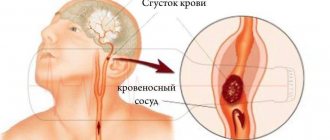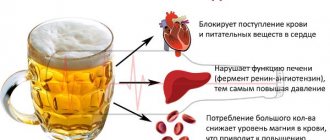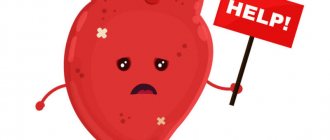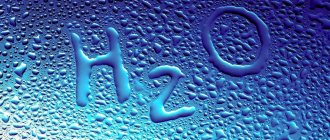- blood pressure surges;
- insomnia;
- migraine;
- decreased ability to work;
- apathy;
- irritability.
Important: medical statistics are disappointing - at least 80% of the adult population suffers from the above signs of VSD. Some autonomic disorders are also observed in schoolchildren (in particular, during puberty, when hormonal levels are “raging”).
The prevalence of the disease leads to the fact that many patients suffering from such unpleasant manifestations are interested in the question: is it possible to drink alcohol during VSD? To answer this, it is worth understanding what vegetative-vascular dystonia is, and what changes in the body of a dystonic patient can occur as a result of drinking alcohol.
Causes of VSD
Vegetative-vascular dystonia is a syndrome caused by disturbances in the functioning of the peripheral nervous and cardiovascular systems.
Symptoms of VSD occur due to inadequate blood supply to the body. Therefore, the brain does not fully receive blood saturated with oxygen, which it needs for normal functioning.
The following etiological factors provoke the appearance of VSD:
- Hereditary diseases;
- Hormonal abnormalities;
- Infectious diseases (acute or chronic);
- Injuries;
- Regular stress;
- Physical inactivity;
- Pathologies of the endocrine system;
- Diseases of the spinal column, especially the cervical spine;
- Emotional lability.
The occurrence of VSD is also affected by:
- Changes in climatic and weather conditions of the environment;
- Not following the daily routine;
- Intense physical activity;
- Increased mental activity.
Possible consequences
Answer: don't drink alcohol. The presence of vegetative-vascular dystonia already indicates the presence of psychological problems. You need to think carefully about what has really been bothering you for a long time and what you so stubbornly want to “run away” from.
Well, if you still can’t quit, then to minimize the number of VSD crises when drinking alcohol, you need to include foods containing glycine in your diet. It improves blood microcirculation. The “natural” version of glycine is jelly, which is useful to “snack” after drinking.
How dangerous is a hangover with VSD:
- Possibility of stroke and heart attack, especially if help is not provided in time after a hangover during an attack of VSD;
- Sudden death even in young people from spasm of coronary vessels;
- Alcohol has diuretic properties. This threatens dehydration during a hangover;
- Provokes crises and aggravates their course.
Nausea, nausea, hands are shaking, legs can’t hold up, your head is pounding, your blood pressure is skyrocketing - these are all sure signs of a hangover. In patients with VSD, they can manifest themselves more clearly and be protracted. Plus terrible remorse for what he did, or rather, what he drank the day before.
If you have regrets about drinking alcohol and feel sick at the mention of drinks, then all is not lost. This is typical for hangover syndrome.
The worst thing is withdrawal syndrome, when a person has no aversion to alcohol, but the body urgently requires a “hangover.” However, a hangover is not a joy either.
In cases of dystonia, not only the vegetative-vascular system suffers. The patient cannot sleep, he is tormented by nightmares, and he wakes up in a cold sweat.
Plus, the entire body is forced to defend itself against acetaldehyde. This is the toxic substance into which alcohol is converted. The first blow is taken by the liver, which is forced to decompose this poison.
The next day, the feeling of a patient with VSD is even less pleasant: the alcohol drunk has a diuretic effect, so the body is dehydrated. Alcohol has a detrimental effect on metabolic processes. Therefore, disturbances in the acid-base balance are possible, and as a result - nausea, shortness of breath, shortness of breath.
In order to stabilize the functioning of the autonomic nervous system, a lot of effort must be made. Although this disease is not accompanied by damage to the vascular wall and internal organs, but only their function suffers, recovery will be quite long.
- First of all, you will need to reconsider your daily routine, work and rest schedule. Be sure to ensure adequate sleep at night (at least 8 hours).
- You will have to give up bad habits (drinking alcohol and smoking) - this is a condition for successful treatment.
- Sports and vegetative-vascular dystonia may well be compatible; it is important to gradually increase the load and avoid overwork. Swimming in the pool and in open bodies of water (river, sea, lake) helps to stabilize the balance between the sympathetic and parasympathetic systems.
- If it is impossible to go swimming, you can choose water procedures as an alternative: contrast showers, rubbing and dousing with cool water to the waist, therapeutic baths
- If there is a tendency to lower blood pressure and you are worried about attacks with general weakness, a drink such as coffee can come to the rescue. It is very important not to exceed your dose, and 2 or 3 cups a day will give you energy and stimulate brain activity (its antioxidant activity will also be an additional bonus).
- Treatment with multivitamin complexes with microelement supplements will help overcome weakness and lethargy. Adaptogenic drugs can cope with this problem even more effectively: tincture of ginseng, young deer antlers, aralia, eleutherococcus, and zamanikha.
- Physical therapy exercises, if performed daily, will give you energy and increase your performance. A properly selected set of exercises can become an alternative to drug therapy.
How does the disease manifest?
Symptoms of VSD are different for each individual patient. Sometimes the signs of VSD are associated with one organ system, sometimes with several at once. Manifestations of VSD occur on the part of the system:
- Respiratory. Shortness of breath occurs, which does not depend on physical activity. It appears even at rest;
- Cardiovascular. The patient's normal heart rhythm is disturbed and the pulse quickens. He feels discomfort in the heart area, tingling;
- CNS. The patient experiences frequent fainting. He is plagued by panic attacks and obsessions. He complains of drowsiness. Headaches, weakness, unreasonable fatigue are constant “companions” of a patient with VSD;
- Psycho-emotional. Change of mood. Frequent depression;
- Excretory. Frequent urination, especially in the evening and at night;
- Gastrointestinal tract. Attacks of nausea and vomiting. Epigastric pain. Abnormal stool.
Attention! Manifestations of VSD – short-term or long-term. Sometimes vascular dystonia occurs latently without any pathological attacks.
With the persistence of pathological attacks, we can talk about neurosis. Somatic disorders lead to the following consequences:
- To a decrease in libido;
- To a violation of thermoregulatory function;
- Increased sweat production;
- To problems with urination;
- To hypertension;
- To disturbances in the gastrointestinal tract (bloating, poor digestibility of food, asthenia).
Article on the topic: Is Mildronate compatible with alcohol?
How dangerous is vegetative-vascular dystonia?
Vegetative-vascular dystonia is a common disease.
Patients suffering from this disease often ask questions: are VSD and alcohol compatible concepts or not, how can one live with this pathology, is it possible to die from VSD? These and other questions can be answered comprehensively in this article.
In addition to drug therapy for vegetative-vascular dystonia, it is equally important to adjust the patient’s lifestyle.
A person who runs in the morning, eats healthy food, and does exercises is unlikely to personally encounter VSD.
Diet
The diet for VSD should be rich in natural and healthy foods that will provide the body with all the necessary substances.
For vegetative-vascular dystonia, it is recommended to eat in small portions 5-6 times a day so that the level of nutrients is always maintained at the same level.
When treating VSD, it is necessary to eat as many vegetables and fruits as possible, which have a beneficial effect on the functioning of the digestive system.
In case of hypertensive type of dystonia, it is necessary to limit consumption of:
- table salt;
- chocolate;
- coffee;
- strong tea.
Which contribute to increased blood pressure.
It is better to eat foods of plant origin, cereals, sea fish and dietary meats.
Nutrition for hypotonic type VSD should consist of cereals, seafood, and fermented milk products. Drinking a glass of warm milk or herbal tea at night helps to relax the body and ensure a good night's sleep.
Diet is also very important, because it has been proven that attacks of VSD become more frequent with weight loss and fasting. Sometimes, to get rid of the signs of hypotonic VSD, it is enough to gain a little weight and start leading an active lifestyle.
A natural and balanced diet for vegetative-vascular dystonia is the key to the patient’s well-being.
Physical exercise
Sports and hardening in general have a positive effect on the entire body. To feel good, it is recommended to engage in feasible sports, breathing exercises, and yoga.
Physical activity during VSD has a positive effect on the patient’s well-being.
After consulting your doctor, you can go to the gym, run in the park in the morning, or simply take long walks on foot. You need to jog at a moderate rhythm, gradually picking up the pace.
After all, sudden loads on the heart and blood vessels can negatively affect the patient’s body, causing symptoms of cardiovascular failure, arterial hypertension or arrhythmia.
You should not put excessive stress on the cardiovascular system during VSD. Heavy types of athletic exercises are also contraindicated for vegetative-vascular dystonia.
To tone the blood vessels after a night's sleep, it is recommended to take a contrast shower in the morning during VSD. This procedure is best performed for hypotonic type of autonomic disorder.
In cardiac and hypertensive types of the disease, the use of a contrast shower can provoke an attack. How to take a contrast shower correctly is very important to achieve the desired effect: first, you need to pour warm water over yourself for 1-2 minutes, then change the warm water to cool water for 2-5 seconds, repeating the cycle 3-4 times.
But swimming with VSD is recommended for everyone, both in natural reservoirs and in the pool. Such hardening has a positive effect on the health of the entire body.
Day and rest routine
With long-term VSD, it is necessary to optimize work and rest. You can work at the computer, but only for a limited amount of time, taking breaks of 5-10 minutes every hour.
With prolonged strain on the eyes, it is necessary to do special exercises that help relax the optic nerve.
It is worth noting that VSD and vision often become the reason for going to the doctor. With constantly low or high blood pressure, visual impairment occurs; this process occurs gradually and may be unnoticeable even to the patient himself.
In such a situation, reduced visual acuity with VSD is discovered by chance during a routine examination.
Another thing is when acute visual impairment occurs during an attack, when the patient feels a loss of visual fields or a dark veil before the eyes. Panic and fear of death grip the patient. In such a situation, qualified medical assistance is necessary.
After normalization of pressure, vision returns.
It is strictly forbidden to work at night, shortening the period of sleep. Healthy and complete sleep during VSD should last at least 7-8 hours. Only by creating favorable conditions can one count on recovery and a reduction in the frequency of VSD crises.
The effect of alcohol on the body
There is a popular belief that alcohol in VSD can be consumed in small doses to alleviate the condition. If you understand the effect of alcohol on the human body, then a small amount of cognac really dilates blood vessels and the patient feels much better for a while.
It is worth remembering that this effect is temporary, and regular consumption of alcoholic beverages has a detrimental effect on all internal organs, with the brain suffering the most from alcoholism.
For males, it should be taken into account that VSD due to alcoholism negatively affects the genitourinary area, and potency suffers the most.
Traditional medicine categorically prohibits drinking alcoholic beverages, because a hangover with VSD is much more severe for the patient and negatively affects all internal organs. In some cases, there is an exacerbation of VSD after alcohol.
Therefore, even alcohol-based medications in most cases are contraindications for vegetative-vascular dystonia.
Effects of nicotine
VSD and smoking are incompatible concepts.
Nicotine has a negative effect on the functioning of the nervous system. Smoking during VSD aggravates the severity of the disease and contributes to the occurrence of crises.
Many patients with experience as smokers are indignant at the advice to give up this addiction, stating that nicotine helps them overcome the vegetative-vascular crisis.
There is some truth in their words, because under the influence of nicotine, the heart rate increases, blood pressure rises and blood supply to tissues improves.
This effect lasts several minutes after smoking a cigarette, and symptoms such as fear and panic attacks instantly disappear. The apparent relief does not last long, so patients with dystonia smoke much more than normal smokers.
It is worth considering the fact that with such a dependence, the heart wears out much faster, and the symptoms of VSD are replaced by symptoms of heart failure.
A person who smokes is addicted, and it is not easy for him to quit this bad habit, but to preserve life and its quality, it is necessary to make the right choice.
Psychotherapy
To achieve stable remission, it is necessary to work in several directions simultaneously, not forgetting the effectiveness of psychotherapeutic sessions.
Patients are concerned about whether this disease is life-threatening, how to live with such a diagnosis, is it possible to drink alcohol, is it possible to smoke, what can and cannot be done, what consequences can VSD have? All these worries and uncertainties make the patient with VSD feel even worse.
Highly qualified doctors recommend combining drug therapy with psychotherapy.
After sessions with a psychotherapist, patients accept their illness and know how to live with it, why VSD is dangerous, that disability does not occur with this pathology, and only advanced cases can be an exception.
After all, vegetative-vascular dystonia is dangerous only in the absence of adequate therapy. If this disease is left untreated, there may be adverse effects on the heart, brain, kidneys and other organs.
With proper treatment and lifestyle, VSD does not pose a threat to the patient’s life.
To reduce the frequency of dystonia attacks, it is necessary to take a comprehensive approach to treatment. Drug therapy comes first in terms of effectiveness, but its effectiveness and stability of the achieved result completely depend on the mental state and lifestyle of the patient. https://vseostresse.ru
Negative effects of alcohol in VSD
Doctors have been saying for a long time that alcohol is harmful not only for ordinary people, but also for people who have been diagnosed with VSD. Alcohol (strong or weak) affects both the autonomic system and the cardiovascular system to the same extent. Statistics note that alcohol lovers are regular patients of neurologists and cardiologists: they are diagnosed with VSD more often than others.
How does alcohol affect the body as a whole? Alcohol has the following effects:
- At first it expands and then narrows blood vessels;
- Coordination of movements becomes unpredictable. A person has difficulty controlling it;
- Reduces the perception of pain, that is, increases the pain threshold;
- Increases the load on blood vessels and the heart.
Many who suffer from VSD believe that alcohol helps with their illness: it improves mood, eliminates weakness, and normalizes their general condition. Such assumptions are valid, but it should be understood that the positive effects of drinking alcohol are temporary. It will definitely be replaced by a hangover.
Are these two concepts compatible?
Patients diagnosed with vegetative-vascular dystonia cannot drink large doses of alcoholic beverages without consequences. Unpleasant symptoms can appear even after the smallest doses of low-alcohol drinks.
Under their influence, small and large vessels suffer; some time after consumption, blood pressure rises, shortness of breath appears, and the pulse increases.
But in case of low blood pressure, you can drink alcohol in small doses. Under its influence, blood vessels dilate, which gives vigor and strength. But the consequences can be pain in the heart and tachycardia.
The most dangerous drink for VSD is beer.
Most people do not take it seriously and use it in fairly large doses. As a result, unpleasant symptoms appear, intoxication occurs, and attacks of the disease occur. Ethyl alcohol tends to destroy the nervous system and brain cells, which is detrimental to people with vegetative-vascular dystonia.
As many believe, alcohol in VSD is not harmful, but even beneficial, since stress is one of the causes of pathology. Alcoholic drink helps relieve fatigue and tension. But this is far from true.
Drinking strong alcoholic beverages helps to significantly reduce the symptoms of hypotonic VSD.
Patients note that after taking small doses, drowsiness, weakness disappear, the feeling of numbness disappears, and a surge of strength is observed.
Alcoholic drinks for the hypertensive type of VSD are strictly prohibited. After consuming even a small amount, the blood vessels begin to dilate, which leads to an increase in symptoms.
Unlike hypotensive patients, hypertensive patients experience weakness, headache, shortness of breath and oxygen deficiency .
VSD and alcohol are two incompatible concepts. The thing is that even in hypotensive patients, improvements in well-being are temporary and can subsequently result in serious consequences and a sharp deterioration in their condition.
Effect of alcohol
After an alcoholic drink enters the body, it instantly begins to spread throughout the body, being absorbed into the blood. It is she who delivers alcohol to various organs. As a result of its influence, a feeling of intoxication appears.
Alcohol is a poison and the body tries to get rid of it through oxidation, during which the functioning of all systems and organs, as well as vascular tone, is briefly disrupted.
Thus, the manifestation and intensification of symptoms under the influence of alcohol is not a rare phenomenon and occurs quite often.
On the other hand, small doses of alcohol are a kind of antidepressant. Under its influence, more adrenaline begins to be produced, and a person’s feelings of anxiety and restlessness decrease.
A particular danger to the body in case of vegetative-vascular dystonia is represented by special substances that are part of the drink and cause dilation of blood vessels and capillaries. For this reason, a person becomes hot, and the upper layer of the epidermis acquires a reddish tint.
Under the influence of alcoholic drinks, the heart rate increases and blood pressure increases. Therefore, attacks of VSD after alcohol occur quite often.
Attacks of VSD after alcohol and symptoms
It is hypothesized that high-quality alcoholic beverages will not lead to the onset or worsening of dystonia symptoms.
But this is a wrong judgment.
The manifestation of signs of the disease is influenced to a greater extent not by the quality of the drink, but by its quantity. Small doses help lift the mood, but consumption in large quantities leads to a hangover.
Vegetative-vascular dystonia develops against the background of constant stress and alcoholism.
Despite the fact that alcoholic drinks have the ability to eliminate depression, after their influence new emotional experiences are added, which significantly aggravates the condition and can lead to the development of attacks.
Regular consumption of alcoholic beverages is contraindicated not only for patients with vegetative-vascular dystonia.
Even a healthy person can experience an attack of VSD, which many mistake for a hangover syndrome, which is characterized by the following symptoms:
- Increased pressure. Alcohol-containing drinks, affecting the body, significantly dilate blood vessels.
- Nausea, vomiting, diarrhea. These symptoms are typical for poisoning with large doses of alcohol.
- Violation of thermoregulation. A person first feels a surge of warmth, which is replaced by chills.
- A depressed state appears, a panic attack appears.
- The heart rate increases significantly.
Many people drink alcohol again to relieve signs of a hangover. Even in small quantities, this again leads to a worsening of the condition, since the blood still contains alcohol.
A new portion only aggravates the situation and causes a new attack.
Should you drink alcohol?
Experts are still arguing about how dangerous the manifestations of the disease are when consuming small doses of alcohol-containing drinks. Based on many years of research, scientists were able to prove that ingestion of a small amount of alcohol has an effect on blood vessels, causing them to expand.
In the absence of new portions, the vessels return to their previous state without showing signs of disease.
Practitioners recommend that patients with VSD drink only high-quality alcohol, but under the following conditions:
- If there are no various concomitant diseases for which the use of alcoholic beverages is strictly prohibited.
- In cases where a person is able to independently control himself and take alcoholic beverages in moderate doses.
- If the manifestations of vegetative symptoms are moderate.
- When the disease is of a hypertensive, cardiac, hypotonic or vagotonic type.
Drinking alcoholic beverages, even in the smallest doses, is strictly prohibited in case of mixed type vegetative-vascular dystonia.
In cases where the pathology manifests itself with pronounced signs, they are constant, and the pain is accompanied by various changes in pulse and pressure.
How to replace bad habits?
It is difficult to completely get rid of bad habits, but not physically, but psychologically. With vegetative-vascular dystonia, the patient needs to abandon them as quickly as possible, as this leads to the development of serious consequences.
One of the most harmful habits, especially with VSD, is smoking.
A person smokes several times a day, thereby causing irreparable harm to health. Drinking coffee drinks, green tea, and various activities that will distract you from the desire to smoke will help you get rid of it. After some time it will disappear completely.
You should also avoid drinking alcoholic beverages.
They can be replaced with sedatives. In cases where it is difficult to get rid of this habit, you need to seek help from a specialist.
Bad habits can be replaced by sports. They will not only help you to distract yourself and calm down, but also restore vascular tone and improve blood circulation.
Swimming, running and walking in the fresh air also have a beneficial effect on the nervous and cardiovascular systems.
In order to get rid of stress, experts recommend attending special trainings and doing yoga. In addition, green and white tea have soothing properties.
Each person must decide for himself whether to consume alcoholic beverages or not. But there are situations when it is very difficult to deny yourself, for example, during the holidays.
In order to avoid the occurrence of attacks of vegetative-vascular dystonia, you must follow several simple rules:
- Drink only high-quality alcohol. Only such drinks will help relieve tension without consequences.
- Wine drinks can be drunk, but not more than 200 ml, the amount of cognac and vodka should not exceed 100 ml. It's better to give up beer.
- Alcoholic drinks can be consumed only if the type of disease is not mixed.
- If symptoms of vegetative-vascular dystonia occur, it is necessary to completely abandon alcohol-containing drinks, as they can cause serious consequences.
VSD and alcohol are incompatible concepts.
Dystonia is one of the most common, but quite dangerous diseases. Characterized by impaired blood circulation to the brain. In some cases, it can lead to the development of encephalopathy.
Alcohol tends to destroy nerve endings, brain cells and blood vessel walls. This is why experts do not recommend drinking alcohol-containing drinks to patients with dystonia.
Complications after drinking alcohol include increased blood pressure, tachycardia, and increased heart rate. https://prososudi.ru/
Changes in the body of patients with VSD after drinking alcohol
Physiological indicators “before” and “after” alcohol intake in patients with VSD undergo significant changes. Thus, a glass of alcoholic drink can increase blood pressure by 1.5 times. Such changes are comparable to changes in the body during a hypertensive crisis. At the same time, the structures of the heart and blood vessels experience severe stress. If a person in such a state physically exerts himself, this will definitely lead him to a myocardial infarction or a pre-stroke state.
A painful attack after drinking alcohol in a person with VSD is accompanied by:
- Increased heart rate and pulse;
- Increased blood pressure;
- Shortness of breath;
- Hyperemia of the skin of the face, neck, chest, upper extremities;
- Increased agitation (aggression), anxiety.
Description of the disease
Vegetative-vascular dystonia is a rather insidious disease that complicates the life of a sick person.
Sometimes he has to completely abandon his usual way of life. Even a moderate form of the disease can reduce a person’s performance by half. A severe stage of the disease can reduce the ability to work to zero.
Vegetative-vascular dystonia can develop very quickly and lead to various diseases:
- hearts;
- gastrointestinal tract;
- hypertension.
The occurrence of mental illness is likely. To avoid serious consequences, strictly follow your doctor's instructions.
In order to find out how alcohol affects the body of a patient with vegetative-vascular dystonia, you need to find out the consequences of the disease itself. Even if you experience a variety of symptoms of VSD, this does not mean that treatment for this disease will not have a positive effect.
If you follow all the recommendations, the disease should not cause serious consequences.
However, if you neglect your health, you will suffer from high blood pressure. Subsequently, this can lead to diseases of the cardiovascular system.
Doctors do not advise neglecting all kinds of prevention methods. It is imperative to normalize the rhythm of life and try to avoid negative emotions.
If negative aspects are still present in your life, do not dwell on them, just switch to any positive memories.
Smoking and VSD
It is a known fact that smoking speeds up blood circulation. Thanks to this, blood pressure rises slightly, vision improves and the brain begins to work more productively.
For patients diagnosed with vegetative-vascular dystonia, such moments bring a feeling of comfort.
Therefore, there are a lot of smokers among them. In addition, they smoke much more cigarettes than healthy people. They just need that feeling of euphoria. But this is only a short-term effect that lasts no longer than half an hour.
The harm from smoking cigarettes is much greater than the apparent positive aspects.
Due to accelerated blood circulation, the vessels also receive increased stress. Accordingly, your heart also suffers: it has to work several times harder, and it wears out much faster.
The harm from smoking is very great, because your life can be shortened by several years. Smoking during VSD is contraindicated.
Alcohol and vegetative-vascular dystonia
Alcohol is extremely undesirable for VSD. We can absolutely say that there is no need to combine alcohol and this disease. There may be the most dire consequences.
When drinking alcohol, the body begins to work in accelerated mode. The pressure may double.
- This can lead to a heart attack, as the heart cannot cope with such stress.
- The likelihood of blood clots increases significantly.
It’s also worth remembering about hangovers. A person with vegetative-vascular dystonia already does not feel very well in everyday life, and his body may simply not be able to withstand a hangover. This condition can be fatal.
It is very difficult for many people to give up alcohol, even if it is strictly prohibited for vegetative-vascular dystonia.
It is also undesirable to drink low-alcohol drinks, such as beer. After drinking alcohol, the body relaxes. It seems that there are no problems, and the person feels easy and good. But this is all an illusion. Drinking alcohol when you have VSD is harmful to your health.
Replacement for cigarettes and alcohol
Is it possible to drink or smoke cigarettes with VSD? The clear answer is no. The body needs to fight your disease, and not have negative consequences from these activities. But it is very difficult to give up your bad habits.
Weigh the pros and cons, and you will see that life without them will become much better and more colorful.
Bad habits can be replaced with other, but useful ones. For example, smoking stimulates your brain. Caffeine has the same effect. Start drinking coffee in moderation and you can quit smoking cigarettes forever.
When drinking alcoholic beverages, you seem to want to calm your nervous system.
You need to escape from reality and forget about all your problems. But in the modern world there are a great many medications that can bring your nervous system to a normal state.
You will become a balanced person and will not be nervous about every little thing. Such drugs, when used correctly, have virtually no side effects, unlike alcohol.
Don't forget about the terrible hangover that will definitely be present the next day.
Another component in the fight against cigarette smoking and alcohol should be sport. Choose the type that suits your liking. When playing sports, endorphins are produced, which are also called the hormone of happiness.
You will always be in a good mood. Plus, you will become stronger and more confident. Dedicate at least 4 days a week to your studies. In addition, physical activity is very useful for vegetative-vascular dystonia.
Watch your health. Avoid bad habits. If you feel unwell, you should immediately consult a doctor. https://gipergidroz.net
Is it possible to drink beer?
Many people do not perceive beer as serious alcohol, which means they can drink it more and more often than vodka or cognac. Therefore, beer poses the greatest danger to patients with VSD.
This drink contains a lower percentage of alcohol than other alcoholic drinks. But in order to fully relax and feel light, you need to drink a sufficient amount of beer. Based on this, the same amount of alcohol enters the body as when drinking strong drinks. With a beer hangover, patients with VSD feel weak, unfocused, and depressed. It is doubly difficult for them to recover after a party: it can take a couple of days.
Article on the topic: Is Mildronate compatible with alcohol?
How is ethanol removed from the body?
Doctors recommend that patients with VSD completely abstain from alcohol. However, many patients cannot eliminate alcohol from their lives. In this case, it is allowed to occasionally drink no more than 50 ml of white wine. Strong drinks (vodka, cognac) should not be consumed under any circumstances.
There are cases when patients experience a severe hangover after taking small doses of alcohol. How long does it take for alcohol to leave the body? And when can you expect your health to improve? The time for ethanol removal is individual. It depends on the gender and body weight of the person, as well as on the amount and strength of alcohol consumed.
To find out the approximate time for ethanol elimination, it is necessary to calculate the blood alcohol concentration. To do this, you need to multiply your body weight by a factor of 0.7 (for men) or 0.6 (for women). Then you need to determine the amount of 100% alcohol consumed in grams and divide it by the resulting number. This is how the concentration of ethanol in the blood in ppm is calculated.
It should be remembered that about 0.1 ppm is removed from the body per hour. However, this figure is approximate. The accuracy of this calculation is about 90%.
Positive effect of alcohol in VSD - myth or reality?
Patients with VSD who have low blood pressure often ask the question: “Is it possible to drink wine and other alcohol with such a history?” Experts say that a glass of high-quality red wine will allow hypotensive people to really feel better: sleep is normalized and vigor appears. Alcohol will expand the vascular walls, and therefore increase blood pressure.
Hypotensive patients should still avoid drinking copious amounts of alcohol. Indeed, in parallel with an upward jump in pressure, people with VSD of the hypotynic type may experience:
- Heartache;
- Headache;
- Increased irritability.
These and other signs of a hangover (weakness, tremors) appear if you do not know the limits in drinking alcohol.
How is VSD of the hypotonic type treated?
It is more difficult to treat hypotonic VSD because it is a rarer form of the disease. Fewer drugs have been developed because it is not economically viable. However, some measures can be taken to alleviate the condition of hypotonic VSD:
- M-anticholinergics.
- Coffee. Caffeine can increase blood pressure, and therefore every person with hypotonic VSD should drink two cups a day. But no more. If you don't like coffee, tea is fine too. In addition to the fact that it contains caffeine, it contains two more alkaloids that are similar in action to caffeine - theobromine and theophylline.
- Chocolate. It also increases blood pressure.
- Vitamins.
For hypotonic VSD, physical activity is indicated, since sport has a positive effect on the functioning of the whole organism. Cardio training is especially beneficial, but strength training should be used with caution. Manifestations of VSD after alcohol in this case are not so critical.
VSD and alcohol: possible risks
The combination of “VSD + Alcohol” is dangerous, since many patients with this pathology are prescribed medications (sedatives). And drinking alcohol in parallel with medications is unacceptable, as it causes significant harm to the body:
- The load on the heart increases;
- Drowsiness appears;
- Responses, like brain function, slow down;
- Problems arise with the stomach and kidney apparatus.
Important! Drinking alcohol during VSD under certain conditions provokes internal bleeding.
Also, drinking alcohol in patients with VSD increases the risk of the latter becoming alcoholics. A person takes alcohol to relieve stress, feel light and achieve what he wants. However, a positive result is always replaced by a hangover, which is eliminated with the same alcohol. The pathology progresses against the background of excessive alcohol consumption, tolerance to alcohol increases, which means that the dose of alcohol also increases each time. The pathological circle closes.
How to deal with a hangover?
Clinical symptoms play a priority role, according to which the scope of assistance is decided. In any case, an important measure to help the patient is to restore water-salt metabolism, eliminate alcohol intoxication and saturate the body with a complex of vitamins.
To relieve mild and moderate intoxication, adsorbents are used, and fatty foods and plenty of fluids are prescribed. Regenerative processes in the body are corrected through high consumption of fruits and vegetables.
To eliminate unpleasant symptoms in the form of fear, a lump in the throat, and other consequences of a hangover with VSD, feasible physical exercises are prescribed to improve general blood circulation and metabolic processes, as well as to quickly remove alcohol breakdown products from the body.
Preventive measures
Not only limiting alcohol can improve the condition of a patient with VSD. Drinks with a high content of coloring substances should be prohibited. Indulgences in the diet lead to an exacerbation of the symptoms of VSD: fried foods, smoked foods, fatty foods. All this needs to be abandoned so that the attacks become fewer or disappear completely. The menu must be filled with cereals, fresh vegetables, fruits, protein products (lean meat, fish). Include chocolate and coffee in your diet in moderation.
Article on the topic: Is Mildronate compatible with alcohol?
You can cope with VSD through vigorous activity, both physical and mental. In the first case, moderate sports (swimming pool, running, fitness, cycling) are suitable. Yoga and Pilates help improve health during VSD, which not only improve physical performance, but also help harmonize the state of mind. The mental and emotional spheres are toned up by classes in groups, where you can get a charge of positivity. These include board games, hobby workshops, dancing, and quests.
Massage with aromatherapy can have a positive effect on the course of VSD. The procedure relaxes, relieves headaches and anxiety. Pleasant floral aromas have a calming effect on the central nervous system.
Herbal medicine can also improve sleep, eliminate depression, and give tone. For this purpose, teas based on chamomile, lemon balm, and St. John's wort are used. Also, tinctures from these plants can normalize fluctuating blood pressure.
Attention! In case of VSD, alcohol-based medications should be used with caution. Alcohol speeds up the absorption of the main components, but in large doses it is harmful to health.
Healthy sleep, proper rest, an adequate daily routine, a positive outlook on the world - all this helps to brighten up the signs of VSD.
In order not to jeopardize your health, doctors advise patients with VSD not to drink alcohol. If you want to drink, then you should limit yourself to 1 glass of wine, but not vodka, cognac and other strong drinks. This will reduce the likelihood of a hangover, which patients with VSD experience very painfully.
Alternative to alcohol
In order to put your psychological health in order, it is best to resort to such methods as physical activity (jogging, swimming, long walks in the fresh air), adequate sleep, proper distribution of work and rest, doing what you love and positive emotions from interacting with nice people. In severe cases, it is recommended to consult a psychotherapist.
We recommend that you read: How to deal with constant premonitions of bad things?
Reviews
Vasily, 42 years old: “I have been suffering from VSD relatively recently. Symptoms began to appear after stress at work. I reduced them to “no” by sports and healthy eating. I had to give up alcohol: after taking it, the attacks became more intense and the hangover longer.”
Veronica, 33 years old: “I have had VSD since childhood: fainting, headaches, weakness. As an experienced patient, I can say that red wine really helps you feel better throughout the day and increases blood pressure.”
Margarita, 25 years old: “I always believed that alcohol helps with VSD. However, experience has shown that taking it worsens my condition more and more. I gave up alcohol completely.”
Dmitry, 30 years old: “I have hypertensive VSD. I haven’t drunk alcohol for a long time, because after drinking alcohol my blood pressure increases sharply. It’s taking me a long time to recover.”
What it is?
But first we need to understand the very essence of this disease. This is a common condition that involves dysfunction of the autonomic nervous system. There are three types of disease:
- Hypotonic . Most often observed in pregnant women and the elderly. It is expressed in a decrease in pressure and instability of the pulse with all that it implies - headaches in the back of the head, decreased mental and physical ability, apathy, and fatigue. With a sudden change in position in space, specific dizziness and darkening in the eyes may occur. In extreme cases, the situation reaches the point of fainting.
- Hypertensive . Usually manifests itself with the same symptoms, with the only exception that the pressure is increased. Although there may be individual signs such as ringing or tinnitus.
- Mixed.
With a mild course of the disease, it is enough for a person to drink light tinctures of valerian or hawthorn to remove negative symptoms and become calmer and more productive. In addition, it will be much easier to fall asleep.
If the course is acute, then from time to time vegetative crises of varying degrees of intensity occur. In especially severe cases, it can lead to convulsions and fainting, followed by a recovery period that lasts several days.
In addition, after such attacks other somatic diseases may appear. But here it is interesting. Tinctures of hawthorn and valerian contain alcohol. So, the answer to the question “is it possible to drink alcohol with VSD” is positive?











